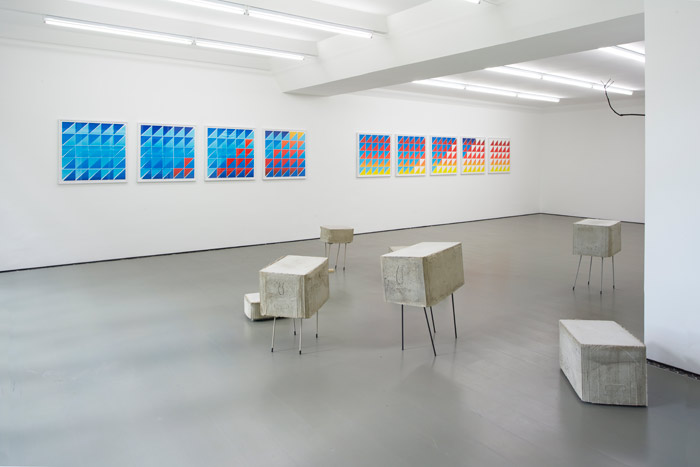Parody and irony entertainingly put what is narrated at a distance. Which of these two rhetorical devices does Judith Hopf employ, when she places a flock of eight sheep appearing to gaze at the entering visitors in the main gallery space? All of these sheep, whose caricature-like faces are hand-drawn, seem to have been made with the greatest possible simplicity. Their dirty gray, concrete bodies are casts of moving boxes either standing on seemingly unstable metal stilts or lying on the floor. To their left, a barren black branch protrudes from the wall about three meters over the floor; it is a bronze titled Dem Kirschbaum ähnelnder Essigbaumast (Branch of a Staghorn Sumac Resembling the Branch of a Cherry Tree). A sequence of screen prints in two groups hangs on the opposite wall. The square prints depict triangles in contrasting colors. Read from left to right, the white, yellow, orange, red, and different blue hues of the geometric forms seem to allude to the course of the day from dawn to noon. In a further room there is another group of prints continuing the sun’s orbit to the afternoon.
The abstracted arrangement of sheep, the orbit of the sun, and the imitation of nature could be interpreted as a parody of the pastoral as a distorted, ridiculed shepherd’s scene. These idealized depictions of an idyll with grazing animals reached their peak during the baroque period. A temple was usually to be found in the background of these pictures. In this exhibition, the background would be what is outside of the gallery space, the sealed-off mansion of Volkswagen’s CEO, Martin Winterkorn. At the end of the rococo period, the temple was replaced by ruins. What also belonged to the rococo repertory was the motif of fêtes galantes, mostly depictions of couples in love.
If one seriously read the arrangement along these lines, the missing amorous couple could refer to the friendship between the artist Judith Hopf and the gallerist Deborah Schamoni. The two made the video Hospital Bone Dance (2006), in which the controlled world of a nurse is affected and disrupted by unexpected and uncanny events.
While the parody is an edifying play requiring knowledge of what it is modeled on, irony criticizes and mocks the prevailing conditions with the means of dissimulation and inversion. A decisive aspect of this topos is that one must not take what is shown or said literally. The flock of sheep made for an exhibition in the town of Lingen in the Emsland region of Germany, evokes both idyllic images and their unsettling disturbance through nuclear piles forming the backdrop of the pastures.
Irony demands skepticism toward social narratives and toward oneself. At the center of Judith Hopf’s relativizing and open method lies her interest in an ongoing process of self-correction and self-relativization. It is difficult to describe where her works position themselves so as to mark both outside and inside. Daniel Pies’ description of the Sun Up / Sun Down series may be a help here, “The order of things is consumed by the haze of shades, overlays and reflections.” This also describes Judith Hopf’s artistic practice.
We know that Gilles Deleuze preferred humor to irony, since he suspected hierarchical thinking in the latter. In humor he found a liberating force at work for the reason that it “…has always undermined games of principles or causes in favor of the event and games of individuation or subjectivation in favor of multiplicities.” (from: Gilles Deleuze & Claire Parnet, Dialogues II [1977]).
In her CAPTCHA series on view in the upper rooms, Judith Hopf operates with humor’s multiplicities and openness.
CAPTCHAs are challenge-response tests that Website providers use for security purposes. These tests are usually employed to check whether the entries in Internet forms were made by humans or machines (robots). One example is a text distorted by an image filter that the user must enter in a field. Computers require pattern-recognition algorithms to process these kinds of images. A great amount of effort is needed to program the algorithms and they make high demands on the software.
These texts are now starting points for Judith Hopf’s short poems. For example, the CAPTCHA “project polisar” is expanded by “means plenty of noise under a rug.” The distorted texts take up the largest part of the DIN A4 sheets and they are surrounded by typed stanzas. The ephemeral poems stand in strong contrast to the elaborate programs behind the CAPTCHAs, but also to the pompous marble floor of the exhibition space, which reveals the previous tenant’s luxurious interior design sins. The order and simplicity suggested by the title Sun Up / Sun Down are humorously entangled in tacit stories about the social sphere and the reception of art that are alluring due to their indeterminacy.
Reviewed by Gürsoy Doğtaş publisher of the Artistzine Matt Magazine
























